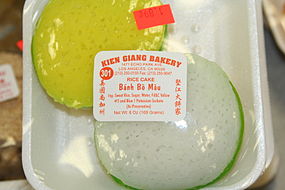- Bánh bò
-
Bánh bò is a sweet, chewy sponge cake from Vietnam. It is made from rice flour, water, sugar, and yeast,[1] and has a honeycomb-like appearance on the inside due to the presence of numerous small air bubbles. Coconut milk is also usually a part of the batter, imparting a slight flavor and aroma of coconut. The cake is of Southern Chinese origin, although the Chinese version, called bái táng gāo (白糖糕), does not contain coconut milk.[1][2] Bánh bò are generally eaten as a dessert, although they may also be consumed as an accompaniment to a meal.
Contents
Etymology
In the Vietnamese language, bánh means "cake," and bò means "cow" or "crawl".[3] The dessert gets its name from its inner texture, which resembles that of beef liver.
Varieties
There are two varieties of bánh bò:
- Bánh bò nướng (literally "grilled bánh bò") - This variety of bánh bò is cooked by baking in a pan in an oven. It is generally off-white or yellowish-white in color on the inside and golden on the outside by caramelized coconut milk. Individual cakes are often large in size, in which case a serving will consist of a slice rather than the whole cake.photo This variety is definitely served alone.
- Bánh bò hấp (literally "steamed bánh bò") is similar in appearance to the baked version. These cakes are often small in size, ball-shaped and cooked from liquid. Bánh bò hấp may be white in color, green (by Pandanus amaryllifolius extract), pink or pale purple (by magenta plant extract).[2] There are three ways to serve this variety. Like bánh bò nướng, it can be used alone. It can be put in the middle of bánh tiêu (chinese hallow doughnuts) and served. Also, people enjoy them in a small dish with coconut milk sauce including tapioca starch on top and a little bit muối mè or muối đậu phộng (literally: sesame salt and peanut salt, respectively).[3]
-
- Both traditional varieties are available in Vietnam as well as in Asian grocery stores in countries with susbstantial overseas Vietnamese populations, such as the United States and France.
- Bánh bò sữa (nướng) (literally "(grilled) milk bánh bò") is a brand new variety of bánh bò appearing in mid 2000s. Coconut milk, the official traditional ingredient is replaced by condensed milk or milk powder. The variety is cooked in a small pan.
- Bánh bò dừa (literally "coconut bánh bò") is the latest variety of bánh bò appearing in late 2000s. It is not generally recognized because it seems totally different from three above mainly from core ingredients. Core ingredients are wheat powder, hen eggs, baking soda and obviously sweetened coconut. It tastes much leathery, seldom hard crispy and silky in skin as opposed three above. In the middle, there is sweetened coconut with cooked mung bean.
The South Indian steamed rice cake called idli is similar in texture, although idli are never sweet. However, the dish is quite similar to the Vattayappam (a type of appam from Kerala, India.)
Notes
- ^ Baking powder is sometimes substituted for the yeast.
- ^ The Chinese version, called bai tang gao (白糖糕; pinyin: bái táng gāo; Cantonese: baak6 tong2 gou1; literally "white sugar cake," is always white and is often slightly sour in taste due to the fermentation of the batter before cooking. The Vietnamese version should not have any sourness.
- ^ "Definition of 'bò' in Vietnamese - English dictionary". http://vdict.com/b%C3%B2,2,0,0.html. Retrieved 2009-06-12.
External links
- Photo of a slice of bánh bò nướng
- Bánh bò hấp recipe
- Bánh bò hấp recipe
- Bánh bò nướng recipe
- Bánh bò nướng recipe
- Discussion about bánh bò nướng
- Photo of green-colored bánh bò nướng
- Alice's Guide to Vietnamese Banh
See also
Categories:
Wikimedia Foundation. 2010.




